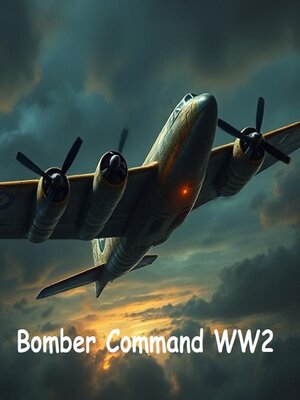
Sign up to save your library
With an OverDrive account, you can save your favorite libraries for at-a-glance information about availability. Find out more about OverDrive accounts.
Find this title in Libby, the library reading app by OverDrive.



Search for a digital library with this title
Title found at these libraries:
| Library Name | Distance |
|---|---|
| Loading... |
Bomber Command in the Second World War
Overview:
RAF Bomber Command was the aerial bombing force of the Royal Air Force (RAF) during World War II. It played a crucial role in the strategic bombing campaign against Germany, targeting industrial, military, and civilian infrastructure. The command operated from 1936 to 1968, with its most intense operations occurring between 1940 and 1945.
Key Aspects of Bomber Command in WWII
1. Formation and Leadership
Bomber Command was established in 1936 as part of the RAF's reorganization.
Air Chief Marshal Sir Arthur Harris became its most famous commander in 1942 and pushed for a strategy of area bombing to break German morale and industry.
2. Early Years & Challenges (1939–1941)
At the start of the war, Bomber Command had outdated aircraft and limited accuracy in night bombing.
Initial missions targeted German naval facilities and infrastructure.
The 1940 Battle of the Ruhr campaign began efforts to weaken German industry.
Early raids were ineffective due to poor navigation and bombing accuracy.
3. The Strategic Bombing Campaign (1942–1945)
The adoption of "area bombing" tactics led to large-scale destruction of German cities.
Introduction of new aircraft like the Avro Lancaster improved bombing effectiveness.
1,000 Bomber Raids (starting May 1942) demonstrated Bomber Command's growing power.
Major operations included:
The Battle of the Ruhr (1943) – targeted industrial heartlands.
The Hamburg Firestorm (1943, Operation Gomorrah) – massive destruction of the city.
The Berlin Raids (1943-1944) – heavy losses but high damage to the German capital.
The Dresden Bombing (February 1945) – one of the most controversial operations, causing tens of thousands of civilian deaths.
4. Tactics and Technology
Used pathfinder aircraft (e.g., Mosquito bombers) to improve targeting.
Developed advanced navigational aids like Gee, Oboe, and H2S radar.
Worked with the USAAF in the Combined Bomber Offensive, where the RAF bombed at night, and the Americans bombed by day.
5. Casualties & Legacy
Bomber Command suffered 55,573 aircrew fatalities – one of the highest loss rates of any Allied force.
Around 125,000 men served in Bomber Command during the war.
Carried out more than 380,000 sorties, dropping over 1 million tons of bombs.
Played a key role in disrupting German war production but remains controversial due to civilian casualties.
A memorial to Bomber Command was finally unveiled in London in 2012, recognizing the sacrifices of its crews.







